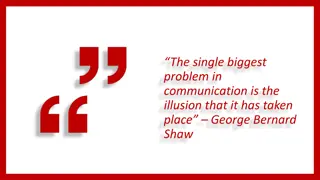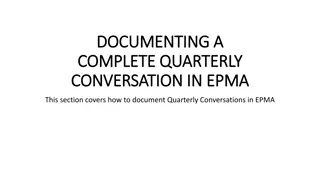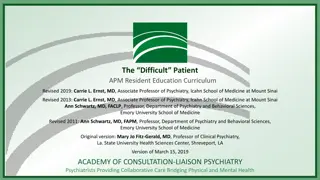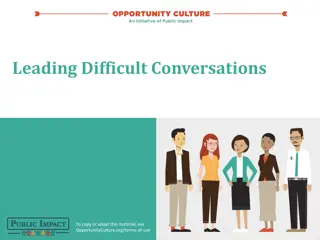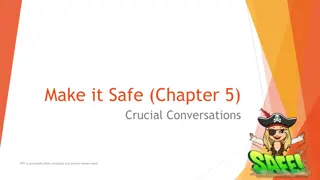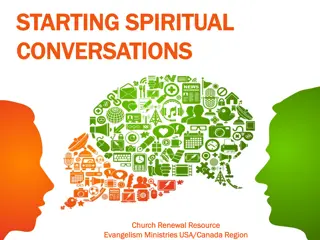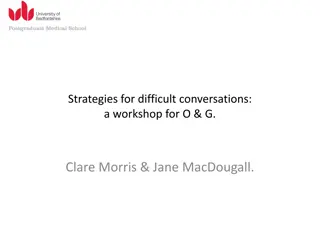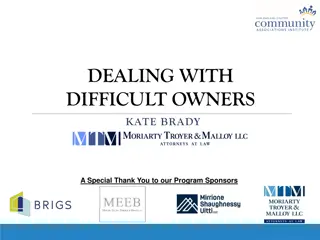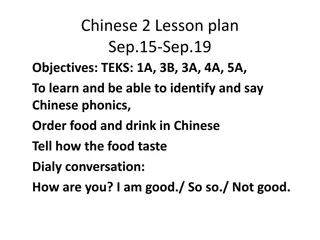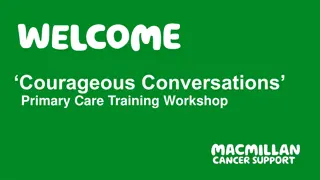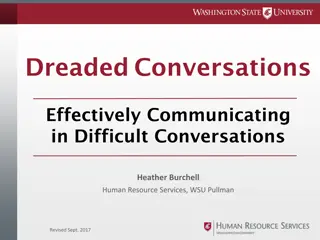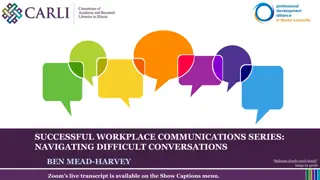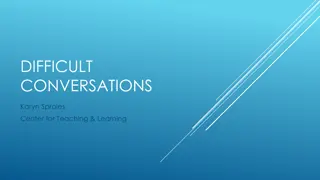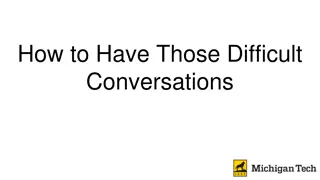Dealing with Difficult Conversations: Workshop Insights
Engage with practical strategies and real-life scenarios to enhance your skills in managing difficult conversations effectively. Explore workshop objectives, agenda details, and case studies to develop a deeper understanding of crucial communication dynamics.
Download Presentation

Please find below an Image/Link to download the presentation.
The content on the website is provided AS IS for your information and personal use only. It may not be sold, licensed, or shared on other websites without obtaining consent from the author.If you encounter any issues during the download, it is possible that the publisher has removed the file from their server.
You are allowed to download the files provided on this website for personal or commercial use, subject to the condition that they are used lawfully. All files are the property of their respective owners.
The content on the website is provided AS IS for your information and personal use only. It may not be sold, licensed, or shared on other websites without obtaining consent from the author.
E N D
Presentation Transcript
Dealing with Difficult Conversations September 14, 2023 Nolley Coaching and Consulting
About Nolley Coaching and Consulting Facilitate Staff Team Building Workshops Mediation and Conflict Resolution Debrief Work Culture Survey Results Assist Work Culture Teams with Action Planning Partner with Manager to Design Work Culture Interventions Individual and Group Coaching Corporate Management Consulting Firm Specializing in Team & Leadership Skills slide 2
Workshop Objectives Prepare managers to facilitate crucial conversations including those that deal w/: Performance Productivity Teamwork Relationship Safety Salary Issues Increase managers comfort and confidence in dealing with crucial conversations Improve managers skill to handle crucial conversations by focusing on contributions vs. blame Build skill in creating learning dialogues
Agenda Crucial Conversations Our Typical Experiences Planning for Crucial Conversations Process & Tools Action Planning Opportunity Facilitating a Crucial Conversation
F A Foster Self- and Other Understanding Awareness A L L Assessing Readiness Learning P A Preparing for the Conversation Application C B Creating Shared Meaning and Finding Common Ground BehaviorChange slide 6
CASE STUDY: Too Much Fun on Night Shift Background and Current Condition: Several Nursing Assistants and RNs frequently congregate around the nursing station, laughing, joking and openly sharing social media on personal cell phones Noise levels on the unit and delayed call bell responses result in frequent patient complaints Senior RNs and charge nurses try to redirect this group without success; they feel frustrated Arguments and lack of cooperation have become normal The newer team members say the senior RNs speak to them disrespectfully; the senior RNs say the newer team members are unprofessional and rude slide 7
What is a Crucial Conversation? Issues have high stakes. Topics are sensitive, important opinions differ Outcome is uncertain CRUCIAL CONVERSATIONS Self esteem: competency, character is at stake Strong feelings include vulnerability
Establish Norms for Dealing with Conflict Increased Conflict Constructive Engagement Managing emotions Self awareness Reaching out Perspective taking/giving Listening for understanding Sharing your thoughts, needs and feelings Offering win-win solutions Willingness to forgive Focus on long term relationship Lashing out in anger/frustration Avoiding or accommodating difficult staff Concerns ignored, devalued Role ambiguity Ineffective communication Lack of trust Misinterpreting behaviors Gossip, disrespect slide 9
No matter how good you get, difficult conversations will always challenge you. So, it is best to keep your goals realistic. Eliminating fear and anxiety is an unrealistic goal. Reducing fear and anxiety and learning how to manage that which remains are more obtainable. Achieving perfect results with no risk will not happen. Getting better results in the face of tolerable odds might. Stone, Patton, Heen Of the Harvard Negotiation Project.
Stephen Covey, in his book, The 7 Habits of Highly Effective People, said In the space between stimulus (what happens) and how we respond, lies our freedom to choose. Ultimately, this power to choose is what defines us as human beings. We may have limited choices but we can always choose. We can choose our thoughts, emotions, moods, our words, our actions; we can choose our values and live by principles. It is the choice of acting or being acted upon. This workshop will help you identify ways to enter into difficult conversations regardless of your role..
Facilitating Crucial Conversations: The Learning Dialogue Step #5 Step #1 Consideration for the Future Diagnose the Conversation #1 Planning #2 The Dialogue #3 The Future Step #2 Step #4 Choose Your Purpose Explore Their Story and Yours Step #3 Begin the Dialogue
Planning & Facilitating Crucial Conversations 1 Diagnose The Conversation 2 5 Choose Your Purpose. Decide Whether to Raise the Issue What s The Issue? Intent / Impact? Feelings Identity Issues Considerations For The Future What do you want to accomplish Is a conversation the best way to do it? Attending to Relationship & Results Invent Options Look to Standards Discuss Ways to keep Communication open A Learning Dialogue 3 Promote Dialogue Speak Straight 4 Explore Their Story & Yours Prepare an opening statement Approach the issue or difference objectively Share your purpose Engage the other to participate Listen to Understand Share viewpoint, perceptions, perspective Reframe, Reframe, Reframe
Step One Diagnose the Conversation
Diagnose The Conversation Do your homework. Review FAQs, monthly reports, expected job results etc. Use the template. Where does your perception and position come from? Information Past experiences Rules Standards What did we each do or not do to get ourselves into this situation? Think contribution vs. blame What is the possible impact that this situation has on you? What might their intentions / reactions be?
Assess Potential Impact Crucial conversations can impact self worth, self esteem, future well being. Common concerns which arise include: Am I competent? Am I a trustworthy? Am I fair? Will they still like me? Will they still do the work?
Ground Your Identity Moving away from all or nothing thinking. I am perfect or I am worthless Accept that you will make mistakes. Realize that your intentions are complex. Take responsibility for what you ve contributed to the situation / problem.
Feelings Examine: How do you handle strong feelings? We often frame feelings out of the conversation. At the very core difficult conversations are about feelings. Hurt / anger/ disappointment, shame, confusion, feeling mistreated, unfairly, without respect Deal with the Feelings Unexpressed feelings can leak into the conversation. Don t evaluate, just share. Avoid judging or characterizing the other s feeling. Realize that feelings can change.
Step Two Choose Your Purpose
Choose Your Purpose What do you want to accomplish? Is it within your control? Is it helpful to you? (learning, understanding, sharing, problem solving, moving forward, etc.) Prepare an opening statement
Speaking Straight A Checklist What is the current situation? What is the desired situation? What, specifically, is the concern, problem, or issue? Who is the appropriate person with whom to speak? What relationship outcome do you want from the conversation? What requests do you have? What actions do you want?
Prepare An Opening Statement One line One clear statement of intent What I need to discuss with you is . . . . . The purpose of our meeting today is . . . We need to talk about . . .
Step Three Promote the Dialogue
Facilitating Crucial Conversations: The Learning Dialogue Step #5 Step #1 Consideration for the Future Diagnose the Conversation #1 Planning #2 The Dialogue #3 The Future Step #2 Step #4 Choose Your Purpose Explore Their Story and Yours Step #3 Begin the Dialogue
STATE Your Perspective Begin with your opening statement Share your facts Tell your story Ask for others paths Talk then listen Encourage testing
Use the SBI Model Situation Behavior Impact
PROMOTE PRIDE! Private Respectful Immediate Detailed End With A Question
State the Facts, Before Concluding: Speak Accountably Facts lead to: Conclusions What I heard was . . . What I concluded is . . . What I saw was . . . What I observed was . . . What I noticed was ., . . What I learned was . . . What I discovered was. . . My research revealed . . . What I decided is . . . The action I want to take is . . What I propose we do is . . . I suggest that we . . . This leads me to believe. . . Based on this, I think we should . . .
Step Four Explore the Other s Story
How to Respond to Silence Ask to get things rolling Mirror, Mirror on the wall Paraphrase to acknowledge the story Prime when you re getting nowhere
Handling People Who Withhold Information or Feelings I've been doing most of the talking during our conversation. Would you be willing to share with me how you are feeling/what your are thinking?" I can understand what you might be thinking, but I don t want to speculate. Is there anything else you want to share? I hear what you re saying. You may need more time to process what I ve said. Would it be helpful if we met again, once you ve had a chance to think this through? Before we go any further, I want to make sure I m not missing something. Is there something you d like to add? I heard what you said, but I am not clear. Please help me to understand. I feel I am hearing two different things. Can you help me sort this out?
Regaining Balance During Emotionally Charged Conversations Let go of trying to control their reaction. Prepare for their response. Imagine that it s three months or 10 years from now. Take a break.
Step Five Considerations for the Future
Facilitating Crucial Conversations: The Learning Dialogue Step #5 Step #1 Consideration for the Future Diagnose the Conversation #1 Planning #2 The Dialogue #3 The Future Step #2 Step #4 Choose Your Purpose Explore Their Story and Yours Step #3 Begin the Dialogue
Ending the Dialogue Confirm next steps. Developing options that meet each person s most important concerns and interests. Attend to the relationship. Keep communication going.
How Can You Use This Information With Upcoming Crucial Conversations?
Case Study/Role Play Assume that you have decided to confront each of the people described below. Write down how you would initiate the conversation with the employee. Be specific, problem-focused and future or change oriented. Try to limit your opening comments; you want to cover what you need, what is happening, and what is to be done about the issue.
Purpose Ask yourself these questions to help you decide what direction you want to take: What reaction do you want from the other person? What do you want them to remember? What do you want them to do as a result of your conversation?
Questions? slide 41
Thank you Nolleycoaching@gmail.com Nolley Coaching Facebook Consultation



